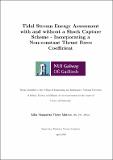| dc.contributor.advisor | Hartnett, Michael | |
| dc.contributor.author | Flores Mateos, Lilia Margarita | |
| dc.date.accessioned | 2019-04-25T13:28:17Z | |
| dc.date.available | 2019-04-25T13:28:17Z | |
| dc.date.issued | 2019-04-23 | |
| dc.identifier.uri | http://hdl.handle.net/10379/15136 | |
| dc.description.abstract | Tidal currents provide a significant energy source in many locations worldwide,
particularly at coastal areas where bathymetric conditions intensify their magnitudes.
Potential sites for tidal-stream energy resource harvesting require realistic assessments
and reliable simulations of effects of turbine arrays on tidal dynamics. Accuracy of
the analysis has direct implications on economic and technical aspects of tidal energy
project developments.
An alternative approach for simulating turbine array energy capture, momentum
sink-TOC, was developed to improve conventional methodologies for assessing tidal-stream energy resource. The method uses a non-constant thrust force coefficient calculated based on turbines operating-conditions, and relates turbine near-field changes
produced by power extraction to turbine thrust forces. Sink-TOC combines linear momentum actuator disc in open channel flows theory with the momentum sink method.
Momentum sink-TOC was implemented in two depth-average complex hydrodynamic models to simulate different marine turbine configurations and to perform tidal-stream energy resource assessments. The first model solves smooth and slow flows
(SSF) with an alternating direction implicit scheme. The second model solves rapidly
varying flows (RVF) combining MacCormack and total variation diminishing schemes.
The RVF solver incorporates a computational less expensive approach for simulating
sharp gradients produced by power extraction than existing techniques. Benchmarking
of numerical results against analytical solutions indicates that both models correctly compute momentum extracted by turbines.
Calculation of turbine velocity coefficients and head drops across turbine arrays
enabled the calculation of turbine efficiency, total power extracted, power dissipated
by turbine wake-mixing, and power available for electricity generation. These metrics
represent an advantage over traditional methodologies used to assess resources. Assessment of bounded flow scenarios through a full fence configuration performed better
using the SSF solver, because head drop was more accurately simulated. However,
this scheme underestimates velocity reductions due to power extraction. Evaluation
of un-bounded flow scenarios through a partial-fence was better performed by the
RVF solver as the head drop was more correctly approximated by this scheme. The
free-surface flow simulations led to identification of non-uniform upstream conditions
for the partial-fence configuration. Computational performance comparisons indicated
that the RVF solver requires higher computational cost independently of domain-size,
and whether energy extraction procedure is incorporated or not.
Tidal-stream energy resource evaluations with fence and partial-fence configurations indicate that a computationally economical pre-assessment can be adequately
performed using an SSF solver. However, more accurate evaluation requires the solution of
the discontinuities produced in the tidal-stream by power extraction. The methodology and numerical models obtained in this research could be use to determine realistic
upper limits of available power with turbine arrays in farm format in real-world coastal
environments. | en_IE |
| dc.publisher | NUI Galway | |
| dc.rights | Attribution-NonCommercial-NoDerivs 3.0 Ireland | |
| dc.rights.uri | https://creativecommons.org/licenses/by-nc-nd/3.0/ie/ | |
| dc.subject | Tidal-stream energy evaluation | en_IE |
| dc.subject | open channel flows | en_IE |
| dc.subject | actuator disc | en_IE |
| dc.subject | non-constant thrust coefficient | en_IE |
| dc.subject | shock-capture capability | en_IE |
| dc.subject | Engineering and Informatics | en_IE |
| dc.subject | Civil Engineering | en_IE |
| dc.title | Tidal stream energy assessment with and without a shock capture scheme - Incorporating a non-constant thrust force coefficient | en_IE |
| dc.type | Thesis | en |
| dc.contributor.funder | Science Foundation Ireland | en_IE |
| dc.contributor.funder | MaREI Centre for Marine and Renewable Energy | en_IE |
| dc.contributor.funder | College of Engineering and Informatics, National University of Ireland, Galway | en_IE |
| dc.local.note | An alternative representation of marine turbines in bidimensional, hydrodynamic
models was developed to improve conventional methodologies to assess tidal-stream energy resource. The method uses the operating conditions of a turbine in
the computation of the momentum extracted by the devices. Its implementation
into two models indicates that a smooth and slow flow solver can be used to pre-assess the resource. However, an accurate assessment requires a rapidly varying
flow solver. This scheme approximates the discontinuities produced in the tidal
stream by power extraction more accurately. | en_IE |
| dc.local.final | Yes | en_IE |
| nui.item.downloads | 4506 | |


